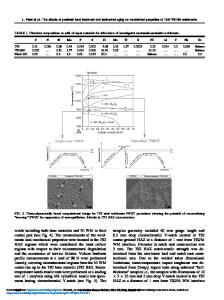Effects of oxygen and heat treatment on the mechanical properties of alpha and beta titanium alloys
- PDF / 5,319,062 Bytes
- 16 Pages / 613 x 788.28 pts Page_size
- 4 Downloads / 396 Views
I.
INTRODUCTION
OXYGEN is the most important interstitial solute in titanium alloys because it strongly influences microstructural and mechanical properties. It is always present in significant concentration in commercial products. Most commercial titanium alloys contain concentrations between 0.10 and 0.20 wt pct oxygen which significantly affect the mechanical properties. 1-4In fact, oxygen is often used as an alloying element to achieve desired strength levels or fatigue performance, 5 although such strengthening usually decreases the fracture toughness. 6 The mechanical properties of alpha/beta titanium alloys have been the subject of much research of which only some is cited here. 7-12Deformation of the alpha phase of Ti-6A14V was investigated as a function of oxygen concentration and aging temperature. 13-19 Investigations have also been made on other near-alpha titanium alloys. 2~ In comparison, there is little {nformation on the mechanical behavior of the minority beta phase in Ti-6A1-4V. 16.17But there has been considerable interest in recent years in beta alloys of similar compositions. 24-29 The individual contributions of alpha and beta phase on the alloys' mechanical properties are not clear. There is a widely held belief that the alpha phase is responsible in a dominant way for the mechanical properties of a + fl Ti-6A1-4V alloys because of its large volume fraction. Also, the age-hardening of Ti-6A1-4V has been assumed to be controlled by microstructural changes in the alpha phase, based on experimental evidence of fine a2 (Ti3A1) precipitation, 13'3~ and based on explanations of oxygen ordering 13'32 and of decomposition of chemically homogeneous a'-laths into a + /3. The precipitation of secondary alpha in beta phase regions during aging is also Z. LIU, Graduate Research Assistant, and G. WELSCH, Associate Professor, are with the Department of Materials Science and Engineering, Case Western Reserve University, Cleveland, OH 44106. Manuscript submitted January 26, 1987. METALLURGICAL TRANSACTIONS A
well documented, 13,33but in the Ti-6A1-4V alloy it has been given little attention because of the relatively small volume fraction of beta. A few have argued otherwise. For example, Lasalmonie et al. 19 concluded from microhardness experiments that not the alpha phase but the minority beta phase was principally responsible for age-hardening of Ti-6A14V alloy. The present work was undertaken to obtain a better understanding of the relative roles of alpha and beta phases in two-phase titanium alloys, in particular Ti-6A1-4V alloy. The objective was to evaluate the microstructure and the mechanical behavior of alpha and beta separately. By preparing two alloys, simulating the compositions of alpha and beta phase, respectively, in Ti-6A1-4V the uncertainty about their individual contributions that arises from phase interaction in alpha/beta mixtures 8'9 is removed. The responses of alpha and beta alloys to heat treatment and to oxygen concentration can then be assessed individually and their respective be
Data Loading...











